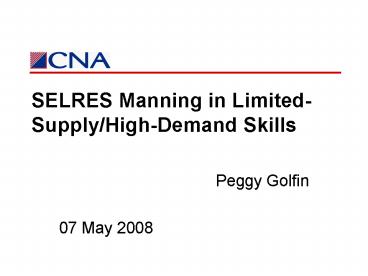SELRES Manning in LimitedSupplyHighDemand Skills
1 / 18
Title:
SELRES Manning in LimitedSupplyHighDemand Skills
Description:
Identify enlisted and officer LS/HD skills. Examine trends in both demand and supply in the past 2 years ... Used to determine ineligibility. The Metric of Interest ... –
Number of Views:40
Avg rating:3.0/5.0
Title: SELRES Manning in LimitedSupplyHighDemand Skills
1
SELRES Manning in Limited-Supply/High-Demand
Skills
- Peggy Golfin
- 07 May 2008
2
Specific Tasks
- Director, Manpower, Personnel, Training and
Mobilization (N0951) assigned us to - Identify enlisted and officer LS/HD skills
- Examine trends in both demand and supply in the
past 2 years - Determine capacity to sustain mission in these
skills - What if scenarios
- We built a model that uses data from the last 2
years to predict capacity for the next 3 years
3
Our Model Predict Quarterly Flows
OUTFLOWS
INFLOWS
Conversions
Conversions, newly rated
Mobilized
NPS recruit
Attrite, retire, separate
Affiliations
Move to IRR, AC
Promote to BU1
Mobilizable BU2s
Move from IRR
Promote from BU3
Not mobilizable medical, legal, EOS
Out of dwell
4
Data Sources
- DMDC provides RCCPDS, Contingency Tracking System
(CTS) - Official DoD data
- We use RCCPDS for promotion, continuation data
- CTS is most accurate mobilization data
- DMDC worked with PERS 461 in FY06 to verify
orders - Voluntary versus involuntary issues
- We impose 15 dwell on all mobilized reservists
throughout the GWOT - Navys Reserve Headquarters System (RHS)
- The only source for MAS, IMS codes
- Used to determine ineligibility
5
The Metric of Interest
- We predict the number of available Servicemembers
for each mobilization requirement for the next 3
years - Assumes status quo in recruiting, promotions,
continuation, mobilization, volunteerism - The farther out we predict, the less accurate the
prediction becomes - Model is less meaningful for skills with few
Servicemembers - We predict under two different scenarios
- The best case The same level of volunteerism
will continue - Mobilization requirements are only the number
involuntarily mobilized the past 2 years - The worst case We add in the number
voluntarily remobilized - A skill is LS/HD when the ratio goes below 6
- May be a function of the time to train or grow
the skill - O5 Pilot vs. E4 CS
6
Volunteers
- Different remobilization policies have been in
effect throughout GWOT - Most reservists were mobilized under a
1-year-mobilized-in-6-years policy - Current policy is maximum of 12 months with 15
ratio of dwell to mobilization - Navys policy has been to involuntarily mobilize
reservists the first time they are mobilized - We define volunteers as reservists mobilized for
at least 4 months in their first mobilization and
remobilized less than 5 years after the date of
demobilization - Allows for up to 3 months of mobilization for
training
7
BU Example
BUs receive New Accession Training (NAT) and PS
Enlistment Bonus E4E6 receive tier 1 level
Reenlistment/Extension Bonus.
8
BU Worst Case Ratio
Threshold
9
Summary
- Of 42 enlisted ratings
- 31 are predicted to be LS/HD now or within 3
years in one or more paygrades - 5 of these are currently not receiving any
recruiting or reenlistment incentives - BM, CS, OS, SK, YN
- The 11 that are not LS/HD
- AME, AW, CTI, CTM, CTN, CTR, CTT, LN, MR, PR, SB
- Most receive recruiting or reenlistment
incentives - Incentives may be preventing some from being
LS/HD, yet some have ratios above 100 - Of the 14 officer designators
- 4 are predicted to be LS/HD Special Warfare
(113X), Info (160X), Supply (310X), CEC (510X) - 3 have ratios above 75 for all paygrades Pilots
(131X), NFO (132X), JAG (250X)
10
Sensitivity Analysis What Would Happen If.
- Recruiting/affiliation increased
- Not practical at higher paygrades
- Sanctuary limits mobilization after 16 years of
active service - Continuation increased
- Rates are already very high for some skills
- Higher rates would be very expensive
- Promotions were faster and more numerous
- Only works if deficit is not at junior levels
- A 1-up/1-down paygrade strategy were used
- Not practical if several paygrades are LS/HD
11
What Would Happen IfContinued
- Mobilization requirements decreased
- Difficult to say no
- Greater volunteerism has same effect on worst
case ratio - Current dwell policy may decrease volunteerism
- Mobilizations were shorter
- Doesnt change the total number of man-years
required - The number not mobilizable decreased
- Shortened training
- Lateral entry of civilians with comparable skills
(Seabees)
12
BU Billets Authorized (BA) Versus Inventory
Worst ratio 5.8
Worst ratio 6.5
Worst ratio 7.7
Worst ratio 2.7
Worst ratio 2.9
13
Effect of 10 Increase in Recruiting on BU Ratio
14
Effect of 3 Increase in Continuation on BU Ratio
Does not include cumulative effect of higher
continuation of lower paygrades on higher
paygrades
15
Effect of 3 Increase in Continuation of BU3 Only
16
Effect of 10 Decrease in Mobilization
Requirements on BU Ratio
17
Total Effect on BU
Includes 3 change in retention, 10 change in
recruiting and mobilization requirements for E4-E7
18
Recommendations
- Conduct sensitivity analyses on more LS/HD skills
- Calculate cost estimates
- Determine the right early warning LS/HD ratio
- Update ratios on a quarterly basis
- Determine effect of recent dwell policy on
continuation - Analyze individual skills in more depth
- Why is retention in some skills so low?
- Is there some way to shorten the training path or
get more active duty time for new recruits? - Are incentives working?
- Are different ones required?
- Are Billets Authorized/mobilization requirements
set correctly? - O4 Pilot ratio is 159
- AW2 ratio is 373
- Improve mobilization data captured































